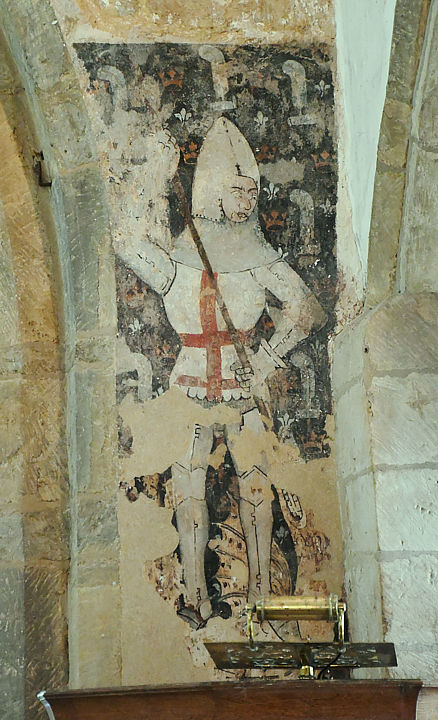Hornton, Oxfordshire (†Oxford) Early (?) C.15
St George (standing) & the Dragon

Photo © Diana Taulbut 2023
It is not uncommon to find George without his horse, and sometimes without the dragon he killed, although that is here beneath his feet at Hornton. The painting is on the south side of the chancel arch wall, in the corresponding position to the battered Pietà on the south.
George is encased in the full plate-armour usually associated with the 15th century and in particular the wars between England and France, including a conspicuously broad solid plate gorget around his neck, rather than the earlier camail or chain-mail hood. But he still has the acutely pointed older-style helmet or bascinet, soon to give way to a lower and more rounded helmet.
Perhaps most interesting of all though is the painted background. This has the heraldic feathers which also appear on the background to the Pietà and are more fully described on that page. There are, though, more of them in this painting, and they are accompanied by small red coronets and white fleur-de-lys (if similar ones were once also on the background to the Pietà they are not visible now).
It is tempting to speculate about these significant-seeming background details. It seems to me that they might well be associated with the period of the treaty-cementing marriage of Henry V to Elizabeth of Valois (she was crowned Queen of England in 1421) and the birth of their first child, the Prince of Wales, later that year. The infant became Henry VI of England on his father’s death in 1422, and King of France on that of his French grandfather Charles VI only a month later.
If this is true, then it is perhaps further evidence of the strengthening status of St George as the primary patron of the ruling house of England. There is an intriguing comparison to be made with a painting in the Bedford Hours showing John, Duke of Bedford, Regent during the child-king’s minority, kneeling before a standing figure of St George who wears the Order of the Garter very conspicuously on his cloak.¹
There is some thought that the figure could be the Black Prince depicted as St George. This page on James Mulraine's website offers some insight into the matter.
The Corpus of Romanesque Sculpture website has more information on the history of the church.
Website for St John the Baptist, Hornton
¹The Bedford Hours, British Library, Additional Ms. 18850, f.256v